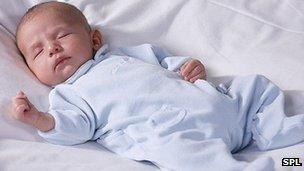Cot death rates at all-time low, say statisticians
- Published

Parents are advised to put babies to sleep on their backs
The number of unexplained infant deaths has continued to fall, reaching an all-time low, figures from the Office for National Statistics (ONS) show.
There were 254 such deaths in 2010 across England and Wales - a rate of 0.35 per 1,000 live births - slightly down from 279 deaths the previous year.
But the Foundation for the Study of Infant Deaths (FSID) says more needs to be done in the worst-hit region.
North-west England has a rate of 0.53 "cot deaths" per 1,000 live births.
The charity's chief executive, Francine Bates, said: "Although we have seen a small reduction in the number of deaths across England and Wales, the figure for the North West is extremely concerning.
"The region has had the highest rate for the last seven years."
The FSID says that with the help of public health agencies, it hopes to cut the number of deaths through Reduce the Risk campaigns.
Back to sleep
While it is not clear what causes the deaths, avoiding smoking is one of the measures recommended to reduce the risk.
Ms Bates added: "We know that smoking is a major risk factor for sudden infant death... the smoking rate for the North West is above the national average."
Others measures recommended to protect infants include putting babies on their backs to sleep and not allowing them to share a bed with the parents.
There is also a suggestion that bacteria may have a role in sudden infant death, although the precise nature of any relationship is not known.
The number of babies dying from sudden infant death before they are 12 months old has fallen steadily in recent years.
This drop is largely attributed to the Back to Sleep campaign, which was launched in 1991.
And for the past few years the overall number of sudden infant deaths has hovered around 300 a year.
While the change in the rate of unexplained infant deaths from 2009 to 2010 is not significant statistically, the fall since 2005 - when the rate was 0.5 deaths per 1,000 live births - is significant.
In 1995, when the figures were first compiled, the death rate was more than 0.6.
Higher rates
As well as regional differences, the ONS figures show that some sections of the population are more likely to experience sudden infant death than others.
The rate among unmarried mothers registering the birth alone - 1.18 per 1,000 - was eight times that of babies born within marriage.
In 2010, more than a third of cot deaths occurred over the winter period, while just over a fifth occurred during the summer. It is thought that overheating and an unsafe sleeping environment, such as the baby's head being covered, may have played a part.
The figures include deaths described both as sudden infant deaths and those for which the cause is "unascertained" after a full investigation. ONS researchers said the terms were used interchangeably by coroners.
- Published17 August 2011